Flotation is the most effective method of removing contaminants such as fats, suspensions, and petroleum substances.
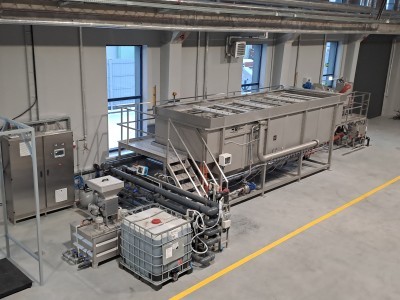
Flotation is the most effective method of removing contaminants such as fats, suspensions, oil-derived substances and other undissolved substances found in industrial wastewater. The separation of these contaminants takes place in chemical processes using coagulants and flocculants (polymers). After separation, separation takes place using a water-air mixture in the flotation chamber. The resulting sludge is discharged outside the system and possibly dewatered before being disposed of, e.g. in a biogas plant.
Biological reactor in which the processes of denitrification, nitrification and sedimentation take place in a programmed cycle in one tank.
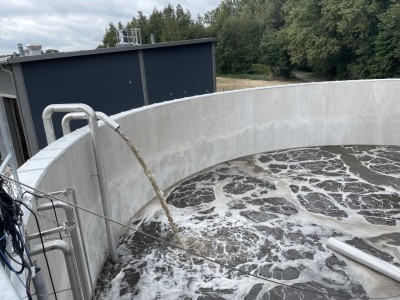
The sequential biological reactor (SBR) is a wastewater treatment system that operates in cycles consisting of several stages. The process begins with filling the reactor with wastewater. This is followed by an aeration phase, in which oxygen is supplied to microorganisms so that they can break down organic pollutants. The next stage is sedimentation, during which clean water is separated from the biological sludge. This is followed by a phase of draining the purified water from the reactor. In the last phase, the reactor is prepared for the next cycle by removing excess sludge. This cycle repeats, allowing continuous wastewater treatment. The SBR is characterized by operational flexibility, which allows the process to be adapted to changing conditions and wastewater loads.
Mechanical separation, i.e. separating solid elements from the wastewater stream

Most industrial wastewater streams contain solids that must be removed before wastewater reaches the treatment plant equipment. Removal of solids is necessary to protect pumps, mixers, sensors and other system components from blocking or even damage. In EMI installations, we use two stages of mechanical pre-treatment: coarse and fine. Coarse pre-treatment removes the largest elements, with a cross-section above 20 mm, and is carried out at the inlet to the first pumping station, before wastewater comes into contact with any pump. Coarse separation devices include vertical screens, basket screens and step/hook screens. The purpose of fine mechanical pre-treatment is to further remove solids, with their cross-section dropping below 3 mm, most often to 1 mm, although in some cases it is appropriate to use even smaller cross-sections (up to 0.25 mm). At this stage, rundown and rotary screens are used. The latter type of screen is used in a system with external or internal inflow. Mechanical pre-treatment involves very low costs, mainly resulting from the consumption of water rinsing the screens. No reagents are used, and energy consumption is minimal. Mechanically pre-treated wastewater is suitable for further treatment by physico-chemical and biological means.
Classic system with nitrification and denitrification tanks and a radial settler.
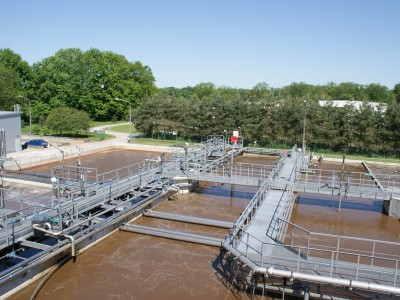
The classic flow biological reactor, also known as activated sludge reactor, is a wastewater treatment system based on the biological decomposition of pollutants by microorganisms. The process begins with the introduction of sewage into an aeration chamber, where it is mixed with activated sludge containing microorganisms. In this chamber, the sewage is aerated, which provides the oxygen necessary for the activity of microorganisms that decompose organic pollutants. Then the mixture of sewage and sludge flows into a secondary settling tank, where sedimentation takes place, i.e. separation of purified water from sludge. The purified water is discharged for further treatment or to a receiving water body. Part of the sludge is recirculated back to the aeration chamber to maintain the appropriate number of microorganisms, and excess sludge is removed. This cycle provides continuous and effective wastewater treatment, using natural biological processes.
An advanced wastewater treatment system that uses anaerobic processes to decompose organic pollutants and produce biogas.
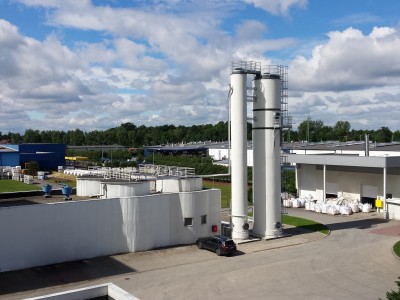
The EGSB (Expanded Granular Sludge Bed) anaerobic biological reactor is an advanced wastewater treatment system that uses anaerobic processes to break down organic pollutants. Wastewater is introduced into the reactor from the bottom, flowing through a layer of granular biological sludge containing anaerobic microorganisms. These microorganisms break down organic matter, producing biogas, mainly methane and carbon dioxide. Due to the high flow rate, the granular sludge rises and expands, increasing the contact surface between the sewage and the microorganisms, which improves the efficiency of the process. The resulting biogas is collected at the top of the reactor and can be used as an energy source. The purified water is discharged from the reactor and the sludge is recirculated, maintaining high biological activity. The EGSB system is efficient and effective, especially for wastewater with a high organic content, offering energy and environmental benefits. EMI supplies EGSB reactors with in-house developed three-phase separators and a raw sewage distribution system.
A wastewater treatment system that uses anaerobic microorganisms to decompose organic matter.
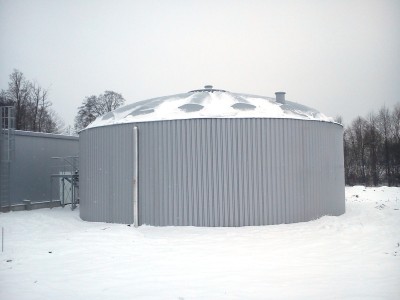
The UASB (Upflow Anaerobic Sludge Blanket) is a wastewater treatment system that uses anaerobic microorganisms to break down organic matter. Wastewater is introduced from the bottom of the reactor and flows upwards through a layer of biological sludge. The microorganisms in the sludge break down organic pollutants, producing biogas, mainly methane and carbon dioxide. This biogas rises to the top of the reactor, where it is collected and can be used as an energy source. The granular sludge acts as a natural filter, retaining solid particles and ensuring efficient wastewater treatment. The purified water leaves the reactor through the top, and part of the sludge is recirculated, which helps maintain high microbiological activity. The UASB is characterized by a simple design, low operating costs and the ability to effectively treat wastewater with a high organic content.
Advanced wastewater treatment system that combines anaerobic decomposition processes with efficient sludge separation.
The anaerobic biological reactor of full mixing with sludge separation in the gas flotation system is an advanced wastewater treatment system that combines anaerobic decomposition processes with effective sludge separation. In the reactor, the wastewater is intensively mixed, which ensures even contact with anaerobic microorganisms that decompose organic matter. During this process, biogas is produced, mainly methane and carbon dioxide. Biogas (or nitrogen) is then used for flotation, i.e. raising sludge to the surface thanks to gas bubbles. The raised sludge is easily collected from the surface of the flotation unit, which allows for its effective separation from the purified water. The purified water is discharged from the flotation unit, while the sludge is recirculated or removed, depending on the needs of the process. This system combines the advantages of intensive mixing and effective sludge separation, which ensures high treatment efficiency and operational stability. A great advantage is also the small amount of sludge produced in the process.
Advanced wastewater treatment system using anaerobic processes and membrane technology.
The anaerobic biological reactor of full mixing with sludge separation in the membrane ultrafiltration system is an advanced wastewater treatment system using anaerobic processes and membrane technology. In the reactor, the wastewater is intensively mixed, which ensures even contact with anaerobic microorganisms that decompose organic matter into biogas, mainly methane and carbon dioxide. After the biodegradation process, the mixture of wastewater and sludge flows through ultrafiltration membranes. These membranes act as filters that retain solid particles, microorganisms and sludge, allowing only purified water to pass through. The purified water is discharged from the system, while the sludge is concentrated and recirculated to the reactor, which allows maintaining high microbiological activity. Ultrafiltration ensures high quality of purified water and eliminates the need for additional sludge separation processes. Thanks to the combination of intensive mixing and advanced membrane technology, this system is very efficient, stable and suitable for the treatment of wastewater with a high content of organic substances.
A modern flow reactor in which ultrafiltration membranes are responsible for the separation of sludge.
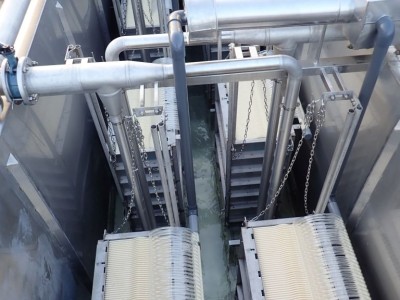
Membrane biological reactor (MBR) is an advanced wastewater treatment system that combines the process of biological decomposition with membrane filtration. In the first stage, wastewater is directed to a biological reactor, where microorganisms break down organic pollutants. Then, the mixture of wastewater and sludge flows through membranes, which act as filters, retaining solid particles and microorganisms, and allowing purified water to pass through. These membranes can be immersed directly in the reactor or placed in a separate filtration module. Thanks to the use of membranes, MBR provides high quality purified water, eliminating the need for secondary settling tanks. This system is effective in removing both organic pollutants and pathogens, so it can be used for various applications, including obtaining water of drinking water quality. MBR is characterized by a compact design and the ability to work with high sewage load, which makes it an effective and versatile solution in wastewater treatment.
A wastewater treatment system that uses biomass carriers immersed in a reactor filled with water.
The MBBR (Moving Bed Biofilm Reactor) is a wastewater treatment system that uses biomass carriers immersed in a reactor filled with water. Wastewater is introduced into the reactor, where the carriers, covered with a biofilm of microorganisms, move freely, providing a large surface area for the degradation of organic pollutants. The microorganisms on the carriers decompose the organic matter, which leads to the purification of the wastewater. The system is aerated to provide oxygen necessary for biological processes and to keep the carriers in constant motion. After purification, the water flows through a sieve separation system that retains the carriers in the reactor, and the purified water is discharged. MBBR is flexible and scalable, which allows for easy adaptation to changing conditions and wastewater loads. Due to its simplicity and efficiency, this system is widely used in various wastewater treatment applications.
Devices for removing water from sediment by pressing, squeezing and other mechanical methods.
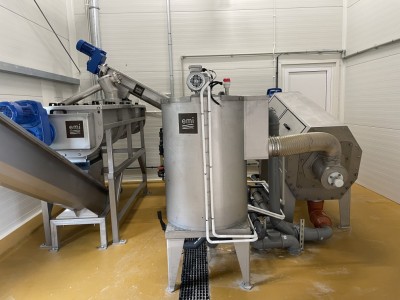
Dewatering of sludge generated during the treatment of industrial wastewater is a key process aimed at reducing the volume of sludge and improving its properties for further processing or disposal. This process involves removing as much water as possible from sludge, which is achieved using various methods, such as centrifuges, filter presses or vacuum dewatering. The main goal of dewatering is to reduce the mass and volume of sludge, which translates into lower transport and storage costs. Dewatered sludge also has better mechanical properties, which facilitates its further processing, such as composting, incineration or biogas production. Additionally, reducing the water content in sludge minimizes the risk of leaks and environmental pollution. The dewatering process can also increase the efficiency of further treatment stages, for example by improving the conditions for anaerobic digestion. Thanks to sludge dewatering, the process of treating industrial wastewater becomes more economical and environmentally friendly.
Averaging to improve efficiency and reduce wastewater treatment costs.
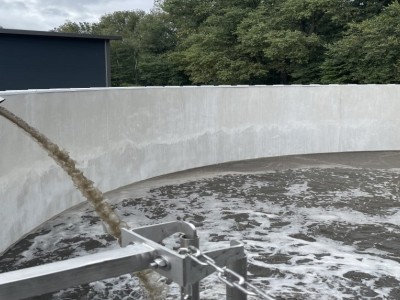
Wastewater in industrial plants is generated in many places and in many processes. As a result, its quantity and composition fluctuate significantly during the day and sometimes many days. Adjusting the treatment process to rapidly changing wastewater would be inefficient and uneconomical. Therefore, in industrial installations we use equalization tanks of appropriate size and equipment. We select the size based on data from the plant, industry knowledge and our own experience. The equipment of equalization tanks may include pumps, mixers, aeration systems, neutralization systems, by-passes and additional interceptor tanks and many other elements carefully selected to meet the requirements of individual cases.
Membrane processes used for wastewater and water treatment.

Ultrafiltration is a membrane process used to purify water by passing it through semipermeable membranes that block particulate matter, bacteria, and viruses. These membranes can come in a variety of shapes, such as flat-sheet and hollow-fiber. Depending on the material they are made of, the membranes can be made of polyvinylidene fluoride (PVDF) or silicon carbide (SiC). The filtration method of the membranes can be from inside to outside (inside-out) or from outside to inside (outside-in). Ultrafiltration modes can be vacuum-driven, where water is drawn through the membranes, or pressure-driven, where water is pushed through the membranes under pressure. In both modes, the membranes retain contaminants, allowing only clean water to pass through. Due to its high efficiency in removing contaminants, ultrafiltration is widely used in the treatment of drinking water, wastewater, and industrial processes.
Technology from the group of advanced oxidation processes used in special cases.
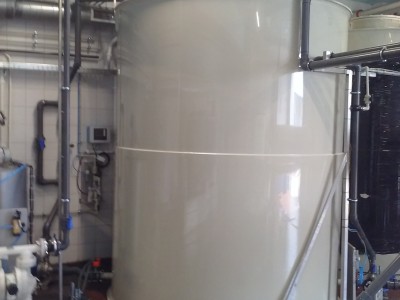
The Fenton process is an advanced oxidation method used in industrial wastewater treatment that uses chemical reactions to degrade organic contaminants. The process involves the reaction of iron (II) with hydrogen peroxide (H₂O₂) to produce powerful hydroxyl radicals (•OH). These radicals are highly reactive and effectively oxidize a wide range of organic contaminants, converting them to less harmful products or completely mineralizing them. In the Fenton process, iron acts as a catalyst, accelerating the reaction and increasing the efficiency of the process. Once the reaction is complete, the byproducts are removed or processed further, and the purified water can be subjected to further treatment steps. The Fenton process is effective in removing difficult-to-decompose contaminants such as industrial chemicals, dyes, pesticides, and some toxic substances.
pH correction in flow or batch mode
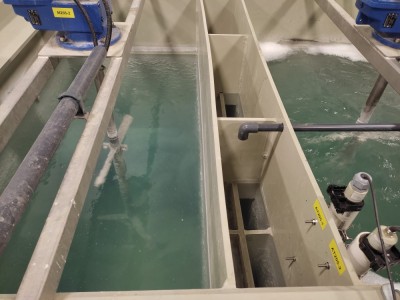
Ensuring the appropriate pH value in sewage is very important for two reasons. Firstly, each receiver (sewage system, environment) requires that the sewage directed to it has a pH within a predetermined range. Secondly, the sewage pretreatment and purification processes themselves require ensuring their appropriate pH. Emi offers a wide range of solutions, from simple systems with one measurement and dosing of one neutralizing agent to complex, multi-stage systems requiring the use of specific neutralizing agents. pH correction can take place at many levels, stages and in one of two modes: flow (online) or batch.
EMI offers specialized containers with built-in equipment for the implementation of any industrial wastewater treatment processes.
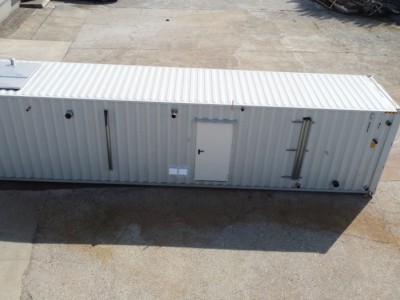
EMI has developed modular container systems in a marine version and designed to be connected into larger systems. The containers we offer have been designed from the ground up to operate in the harsh conditions of industrial sewage treatment plants. The interiors are lined with 100% stainless steel, have heating, ventilation, health and safety devices and individually configured technological equipment. The use of container construction allows for the shortest possible project implementation time. The entire installation is prefabricated in the EMI production plant and is delivered ready for start-up immediately after connection on site (in some cases preparatory works are required, such as tanks and underground networks, ground hardening, etc.). EMI's offer also includes tanks in containers that can perform averaging, storage and even become biological reactors.